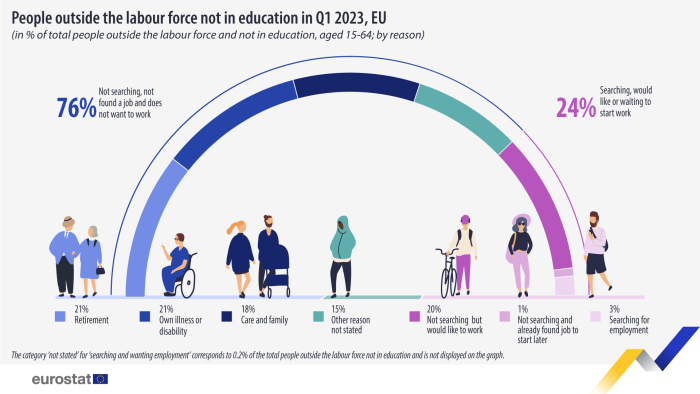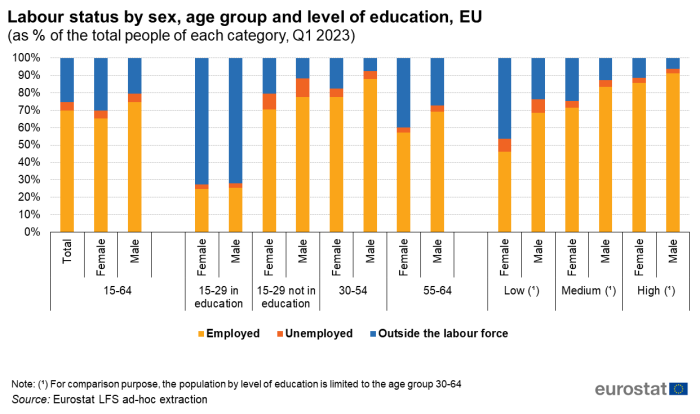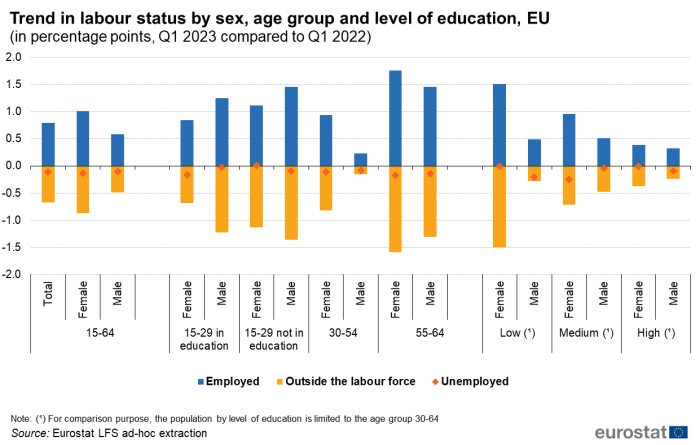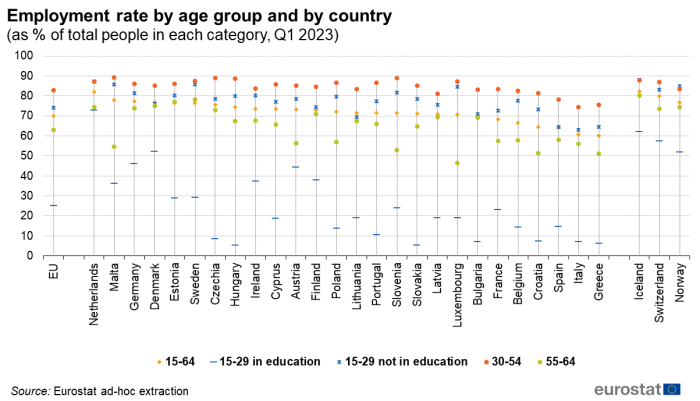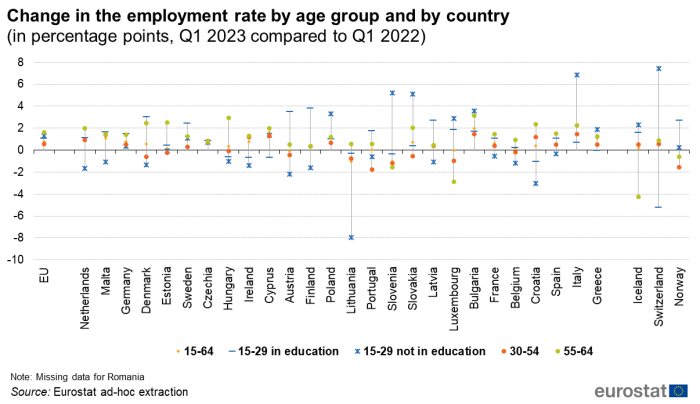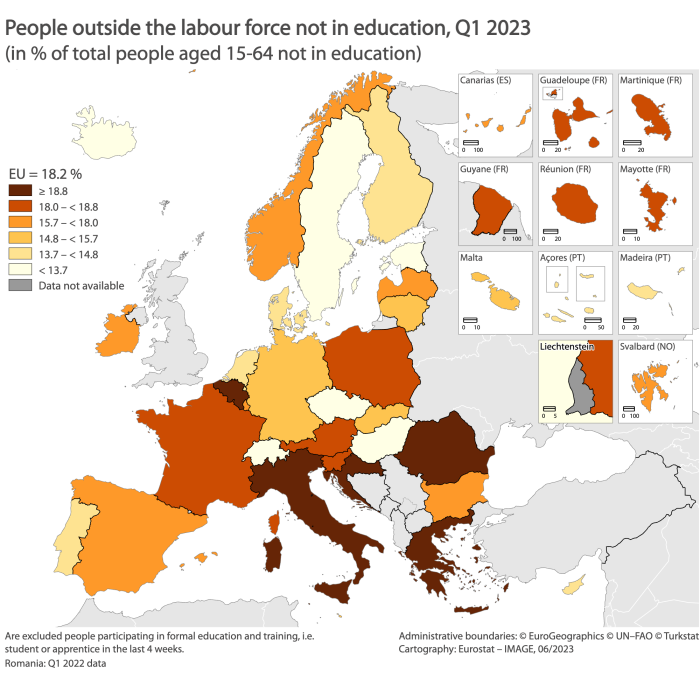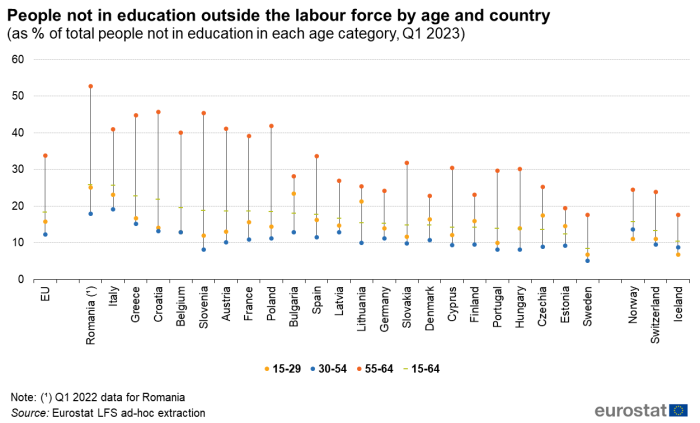Archive:Key figures on the changes in the labour market
Data extracted in June 2023
Planned article update: December 2023
Highlights
This article addresses the most significant changes in the labour market between the first quarter of 2022 and the first quarter of 2023, with focus on people outside the labour force, meaning neither employed nor unemployed. This overview aims to answer the following questions: was the increase in the employment rate the same for younger and older workers at all levels of education? How many people not in education are outside the labour force and what is their attachment to the labour market?
The analysis is carried out for the European Union (EU) as a whole, for the 27 EU Member States individually and for three EFTA countries (Iceland, Norway and Switzerland). It makes use of non-seasonally adjusted quarterly data from the European Union Labour Force Survey (EU-LFS).
Full article
Trends in employment at EU level
Highest increases in the employment rate reported by women aged 55-64 years and by women with a low level of education
People by labour status are analysed using the European Union Labour Force Survey (EU-LFS) data. A closer look at the various categories acting on the labour market shows that age, sex as well as level of education are key factors for employment analysis but are also important for unemployed people or those outside the labour force.
In Q1 2023, 7 out of 10 people aged 15-64 years (69.9 %) were employed in the EU, 4.8 % were unemployed and 25.3 % were outside the labour force (see Figure 1). The employment rate in Q1 2023 varied significantly among the different population groups as shown in Figure 1: there was a large gap (9.4 percentage points (pp)) between the sexes with 65.2 % of employed women and 74.6 % of employed men. The same gap was recorded for those outside the labour force, with 30.1 % of women and 20.5 % of men not employed, not searching for a job, or not available to start within the following two weeks.
Considering the age, Figure 1 shows the employment rate in Q1 2023 by age group and distinguishes people aged 15-29 years participating in formal education in the last 4 weeks and those who were not. This consideration is highly relevant when dealing with the employment rate of young people. Indeed, exactly half of people aged 15-29 years are still in education in the EU, which significantly affects the denominator of the employment rate (i.e. the total people of this category).
In Q1 2023, the employment rate in the EU was:
- around 25 % for people aged 15-29 years participating in formal education (25.5 % for men against 24.8 % for women);
- 70.4 % and 77.7 % for women and men aged 15-29 years not participating in formal education;
- 77.6 % and 87.9 % for women and for men aged 30-54 years;
- 57.1 % and 69.2 % for women and for men aged 55-64 years.
The older the people, the wider the gender employment gap.
Looking at unemployment in Q1 2023, the share of unemployed women in the total women aged 15-64 years (4.6 %) was slightly less than the male share (4.9 %). Unemployment reached its highest value among men aged 15-29 years not participating in formal education (10.6 %) and the lowest among men aged 15-29 years still in formal education (2.4 %). Furthermore, in Q1 2023, almost three-quarters of women and men aged 15-29 years participating in formal education were outside the labour force (neither employed nor unemployed). Considering people aged 15-29 years not in formal education, it was 1 in 5 women (20.5 %) and 1 in 10 men (11.7 %) who were outside the labour force. In the same quarter, EU accounted for 17.6 % of women and 7.5 % of men aged 30-54 years outside the labour force and 27.3 % of men and 39.9 % of women aged 55-64 years.
The level of education also significantly affects the employment rate. Figure 1 compares people aged 30-64 years by level of education and labour status in the EU. Lower levels of education are associated with lower employment rates. In Q1 2023, people with a low level of education reported the lowest employment rates: 46.3 % of women and two-thirds of men were employed (68.5 %). People with a medium level of education follow, with 71.3 % employed women and 83.4 % of employed men. The highest rates were recorded among women and men with a high level of education, with 85.6 % and 91.2 % respectively.
Between Q1 2022 and Q1 2023 as shown in Figure 2, the employment rate increased by 0.8 pp for all people aged 15-64 years. However, the increase in employment was more pronounced for women aged 55-64 years (+1.8 pp), for men aged 15-29 years not participating in formal education and for men aged 55-64 years (+1.5 pp for both categories). While men aged 15-29 years recorded higher increases than women, it is worth highlighting that it was the opposite for those aged 30-54 years and 55-64 years.
Also, as clearly shown on Figure 2, the increase in the employment rate of young women not in education and in the rate of women aged 30-54 years was accompanied by a similar decrease in the share of people outside the labour force while the share of unemployed people recorded minor change or none. For men aged 15-29 years not in education and women and men aged 55-64 years, the increase in the employment rate was also recorded with a greater decrease in the share of people outside the labour force than in the share of unemployed people. Only men aged 30-54 years compensated a higher employment rate by a greater decrease in the unemployment rate than in the share of people outside the labour force.
Moreover, considering the level of education among people aged 30-64 years, the increase in the employment rate from Q1 2022 to Q1 2023 was more pronounced for women with a low level of education (+1.5 pp). The lowest increases have been recorded by women and men with a high level of education, +0.4 pp and +0.3 pp respectively.
Trends in employment at country level
More than half of the EU Member States recorded a lower employment rate among people aged 15-29 years not participating in education in Q1 2023 compared with Q1 2022
At national level (see Figure 3), in Q1 2023, the employment rate of people aged 15-64 years was the highest in the Netherlands (82.1 %), Malta (78.0 %) and Germany (77.2 %). On the contrary, countries with the lowest employment rates were Greece (60.3 %), Italy (60.6 %) and Spain (64.1 %). As shown in Figure 3, those three countries also have the lowest employment rates of people aged 15-29 years not in education and aged 30-54 years. Please note that Q1 2023 data is missing for Romania. The employment rate of people aged 15-29 years participating in education and the rate of people aged 55-64 years varied to a much greater extent among countries than the rate of the other categories. An example of this is that during Q1 2023, the employment rate of people aged 55-64 years varied from its highest point of 78.2 % in Sweden to its lowest of 46.4 % in Luxembourg. Meanwhile, the employment rate of people aged 15-29 years still in formal education varied from 72.9 % in the Netherlands to 5.2 % in Slovenia.
Moreover, it is worth noting that between Q1 2022 and Q1 2023, the employment rate of people aged 15-64 years increased in all but four EU Member States (see Figure 4), namely in Lithuania and Slovenia (both, -1.0 pp), Austria (-0.1 pp) and in Luxembourg where it remained stable. Looking at the specific age groups for the 26 EU Member States for which data is available (all but Romania), a decrease in the employment rate was recorded in
- 7 EU Member States for people aged 15-29 years participating in formal education;
- 15 EU Member States for people aged 15-29 years not participating in formal education;
- 10 EU Member States for people aged 30-54 years;
- 2 EU Member States for people aged 55-64 years (namely Luxembourg and Slovenia).
People not studying and outside the labour force: overview
Looking at people who are not in education and who are outside the labour force, meaning those neither employed nor unemployed is a relevant indicator to fully analyse untapped potentials of employment. People who were still in formal education or training are excluded from the following analysis in order to better capture this phenomenon and understand the other reasons why people aged 15-64 years do not work (i.e. employed) or, are not available and do not search for a job (i.e. unemployed).
In Q1 2023, among people aged 15-64 years who did not participate in formal education or training, 18.2 % were outside the labour force in the EU. The map reveals significant differences in Q1 2023 among EU Member States. Please note that Romanian data refers to Q1 2022 due to missing data for Q1 2023.
- The share of people aged 15-64 years who were not studying and outside the labour force was above 18.8 % (see the countries in dark red) in Romania (25.8 %), Italy (25.6 %), Greece (22.8 %), Croatia (21.8 %) and Belgium (19.6 %).
- On the other hand, this share was the least in Sweden (8.3 %), Estonia (12.3 %) and Czechia (13.6 %). Two EFTA countries also appear in the low range: Iceland (10.4 %) and Switzerland (13.3 %).
Looking at the same indicator by age group (see Figure 6), it can be seen that, in the EU, the highest share of people not studying and outside the labour force was registered for people aged 55-64 years (33.8 %), followed by people aged 15-29 years (25.8 %) and those aged 30-54 years (17.9 %). This pattern is also observed in 22 out of 27 EU Member States.
- Among people aged 15-29 years not participating in education, the highest shares of people outside the labour force were recorded in Romania, Bulgaria, Italy and Lithuania, all between 20 % and 25 %. On the other hand, less than 10 % of young people not in education were outside the labour force in Sweden and Portugal (6.8 % and 9.9 %).
- For people aged 30-54 years, Italy, Romania (with Q1 2022 data), Greece and Croatia ranked first registering shares from 19.1 % for Italy to 13.1 % for Croatia while Sweden, Slovenia, Portugal, Hungary and Czechia recorded the least shares all between 5 % and 9 %.
- Focusing on people aged 55-64 years, the Eu Member States registering the highest shares of people outside the labour force in Q3 2021 were Romania (52.7 %), Croatia (45.7 %), Slovenia (45.4 %) and Greece (44.8 %). The least shares were observed in Sweden, Estonia, Denmark, Finland and Germany, all between 17 % and 24 %.
People not studying and outside the labour force: reasons and attachment to the labour market
People who were not participating in education and were outside the labour force in Q1 2023 might present different profiles and an attachment more or less close to the labour market although they were neither employed nor unemployed. As seen in Figure 7, among those 44.0 million people aged 15-64 years not in education and outside the labour force,
- 33.2 million (75.5 %) were not searching for employment, did not find a job to start later and did not want to work. This share consisted of 21.1 % of people who did not want to work because they were retired, 20.7 % because of own illness or disability, 18.2 % because of care and family reasons and 15.4 % because of other reasons e.g. personal reasons (and not stated). While women were more numerous than men in all categories of people not studying and outside the labour force, the difference between the sexes was much more visible among those who did not want to work due to family and care reasons: females accounted for 7.6 out of 8.0 million in this category.
- 9.0 million people (20.3 %) were not searching for employment, did not find a job to start later but would have nevertheless liked to work.
- 1.2 million people (2.8 %) were searching for employment but were not immediately available in order to be registered as unemployed people.
- 0.5 million people (1.2 %) were not searching for employment and had already found a job to start later (1.2 %).
- 0.1 million (0.2 %) did not report their search status.
Source data for tables and graphs
Methods and definitions
All figures in this article are based on non-seasonally adjusted quarterly results from the European Union Labour Force Survey (EU-LFS).
Data sources
Source: The EU-LFS is the largest European household sample survey providing quarterly and annual results on labour participation of people aged 15 years and over as well as on persons outside the labour force. It covers residents in private households. Conscripts in military or community service are not included in the results. The EU-LFS covers the same target populations and uses the same definitions in all countries, which means that the results are comparable between the countries. The EU-LFS is an important source of information about the situation and the trends in the national and EU labour markets. Each quarter, around 1.8 million interviews are conducted throughout the participating countries to obtain statistical information for some 100 variables. Due to the diversity of information and the large sample size, the EU-LFS is also an important source for other European statistics such as Education statistics or Regional statistics.
Coverage: The results from the survey currently cover all European Union Member States, the EFTA member states Iceland, Norway and Switzerland, as well as the candidate countries Montenegro, North Macedonia, Serbia and Türkiye. For Cyprus, the survey covers only the areas of Cyprus controlled by the Government of the Republic of Cyprus.
In the analysis by economic activity and occupational group, only those activities and groups with more than 100 000 employed people at EU level are taken into account.
European aggregates: EU refers to the totality of the EU of 27 Member States. If data are unavailable for a country, the calculation of the corresponding aggregates takes into account the data of the same country for the most recent period available. Such cases are indicated.
Country notes
In the Netherlands, the 2021 LFS data remains collected using a rolling reference week instead of a fixed reference week, i.e. interviewed persons are asked about the situation of the week before the interview rather than a pre-selected week.
Definitions
- The concepts and definitions used in the EU-LFS follow the guidelines of International Labour Organisation (ILO). In particular, employed people comprise:
(a) persons who during the reference week worked for at least one hour for pay or profit or family gain;
(b) persons who are not at work during the reference week but had a job or business from which they are temporarily absent.
- The LFS employment concept differs from national accounts domestic employment, as the latter sets no limit on age or type of household and also includes the non-resident population contributing to GDP and conscripts in military or community service but excludes the resident population working for non-resident enterprises.
More information
More information on the LFS can be found via the online publication EU Labour Force Survey, which includes eight articles on the technical and methodological aspects of the survey. The EU-LFS methodology in force from the 2021 data collection onwards is described in methodology from 2021 onwards. Detailed information on coding lists, explanatory notes and classifications used over time can be found under documentation.
Context
2021 was marked by the recovery from the COVID-19 pandemic and by an employment rate recording an upward trend. So far, despite Russia's invasion of Ukraine and the start of the energy crisis, employment has still been going up. Nevertheless, older workers aged 55-64 years record the most substantial increase in their employment rate comparing with younger people as the duration of working life has become longer in many countries. Furthermore, in the last years, it has been of interest to follow the development of the population according to the the three labour statuses i.e. employment, unemployment and people outside the labour force. Indeed, the variation in employment has been in some quarters mainly reflected by changes among people outside the labour force instead of unemployment.
Direct access to
- New measures of labour market attachment - Statistics in focus 57/2011
- Labour force survey in the EU, EFTA and candidate countries — Main characteristics of national surveys, 2020, 2022 edition
- Quality report of the European Union Labour Force Survey 2020, 2022 edition
- EU labour force survey — online publication
- European Union Labour force survey - selection of articles (Statistics Explained)
- LFS main indicators (lfsi)
- Unemployment - LFS adjusted series (une)
- Supplementary indicators to unemployment - annual data (lfsi_sup_a)
- Supplementary indicators to unemployment - quarterly data (lfsi_sup_q)
- Unemployment - LFS adjusted series (une)
- LFS series - Detailed annual survey results (lfsa)
- Total unemployment - LFS series (lfsa_unemp)
- Supplementary indicators to unemployment by sex and age (lfsa_sup_age)
- Supplementary indicators to unemployment by sex and educational attainment level (lfsa_sup_edu)
- Supplementary indicators to unemployment by sex and citizenship (lfsa_sup_nat)
- Total unemployment - LFS series (lfsa_unemp)
- LFS series - Detailed quarterly survey results (lfsq)
- Total unemployment - LFS series (lfsq_unemp)
- Supplementary indicators to unemployment by sex and age (lfsq_sup_age)
- Supplementary indicators to unemployment by sex and educational attainment level (lfsq_sup_edu)
- Total unemployment - LFS series (lfsq_unemp)
Methodology
Publications
- EU labour force survey — online publication
- Labour force survey in the EU, EFTA and candidate countries — Main characteristics of national surveys, 2020, 2022 edition
- Quality report of the European Union Labour Force Survey 2020, 2022 edition
- New measures of labour market attachment - Statistics in focus 57/2011
ESMS metadata files and EU-LFS methodology
- Employment and unemployment (Labour Force Survey) (ESMS metadata file — employ_esms)
- LFS series - detailed quarterly survey results (from 1998 onwards) (ESMS metadata file — lfsq_esms)
- LFS series - detailed annual survey results (ESMS metadata file — lfsa_esms)
- LFS ad-hoc modules (ESMS metadata file — lfso_esms)
- LFS main indicators (ESMS metadata file — lfsi_esms)
- LFS regional statistics (ESMS metadata file — reg_lmk)
